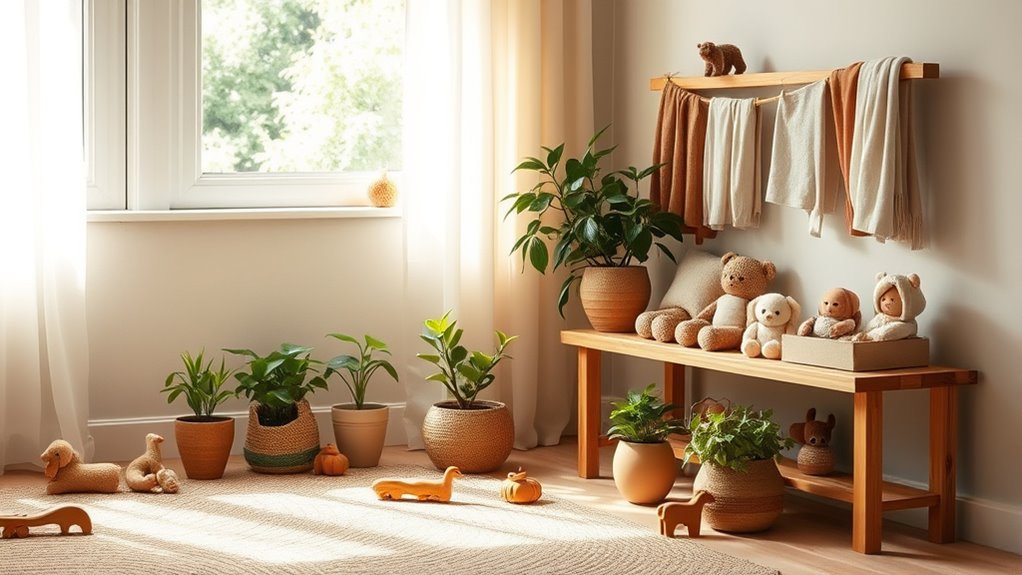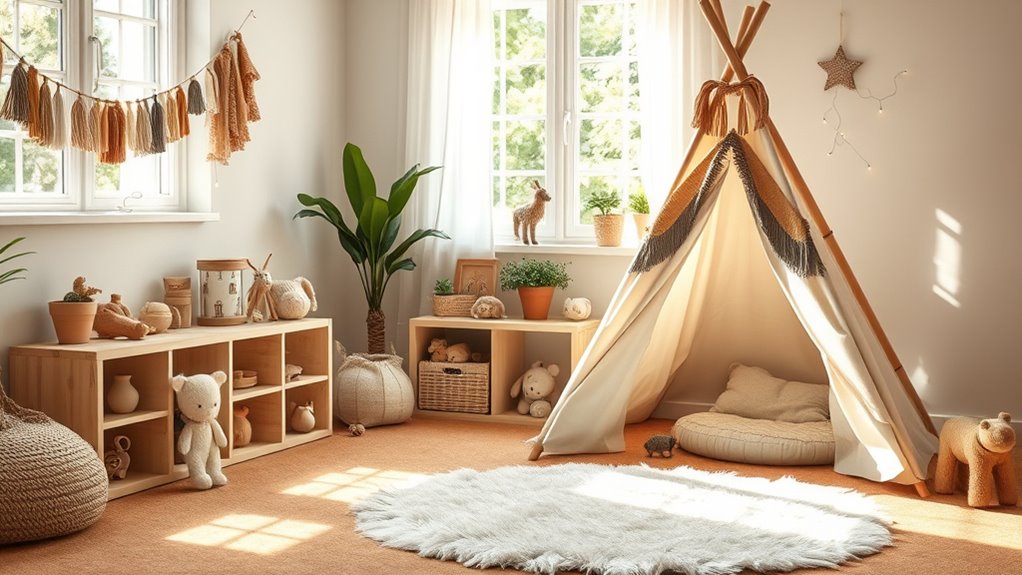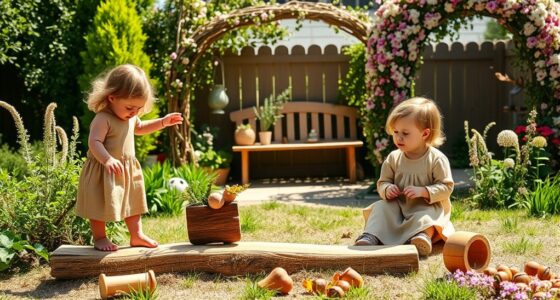To create a Waldorf-inspired play space at home, use natural materials like wooden toys, silk scarves, and woolen balls. Choose soft, muted colors such as gentle greens and warm creams to create a calming atmosphere. Keep the space clutter-free with open storage and designate different zones for reading, drawing, and imaginative play. Focus on simplicity and harmony to foster curiosity and holistic development—exploring these ideas further will help you craft a nurturing environment.
Key Takeaways
- Use natural, sustainable materials like wooden toys, woolen balls, and silk scarves to promote sensory development and eco-friendliness.
- Incorporate a soft, muted color palette with greens, browns, blues, and creams to create a calming, harmonious environment.
- Maintain a clutter-free space with open storage made of natural fibers, making toys accessible and encouraging independence.
- Designate specific zones for quiet activities and imaginative play, using cushions, small tables, and natural materials.
- Foster a nurturing atmosphere aligned with Waldorf principles, supporting curiosity, holistic growth, and a deep connection to nature.

Creating a Waldorf-inspired play space at home offers a wonderful way to nurture your child’s natural curiosity and imagination. To achieve this, focus on using natural materials that are gentle on your child’s skin and promote sensory development. Opt for wooden toys, silk scarves, woolen balls, and other handcrafted items made from sustainable resources. These materials foster a warm, inviting environment that encourages open-ended play, allowing your child to explore and create freely. Natural materials also age gracefully, adding character to your play space over time and avoiding the plastic, artificial feel of many modern toys.
Create a warm, inviting play space with natural materials like wood, silk, and wool to nurture curiosity and imagination.
In addition to selecting natural materials, incorporating soft colors into your play environment is essential. Choose a palette inspired by nature, such as muted greens, gentle browns, soft blues, and warm creams. These colors create a calming atmosphere that helps your child feel secure and focused. Soft colors aren’t just visually soothing—they also support emotional well-being, reducing overstimulation and fostering a peaceful space for imaginative play. You can incorporate these colors through wall paint, rugs, cushions, and decorative elements, creating a cohesive, harmonious setting.
Keep the space simple and clutter-free to allow your child’s imagination to flourish. Use open shelves or baskets made from natural fibers to organize toys and materials, making everything accessible and easy to put away. This not only encourages independence but also teaches your child to respect their environment. Avoid overstimulating patterns or bright, contrasting colors that could distract or overwhelm. Instead, aim for a serene and balanced environment where your child can focus on their play and exploration.
Creating zones within the play space can help your child navigate different types of activities. For example, designate a corner for quiet, contemplative activities like reading or drawing with soft-colored cushions and a small wooden table. Another area can be dedicated to imaginative play, with natural blocks, dolls, and dress-up clothes. By thoughtfully arranging these zones, you help your child develop a sense of order and purpose while encouraging diverse types of play.
Ultimately, a Waldorf-inspired play space isn’t about perfection; it’s about creating an environment that respects your child’s developmental needs. Using natural materials and soft colors helps cultivate a nurturing, inspiring atmosphere where your child can grow, imagine, and learn through play. Additionally, integrating Waldorf educational principles can enhance your child’s holistic development and deepen their connection to nature. With careful attention to these elements, you’ll foster a space that supports your child’s natural curiosity and sparks their love for discovery.
Frequently Asked Questions
How Much Does It Typically Cost to Set Up?
Setting up a Waldorf-inspired play space typically costs between $200 and $800, depending on your budget considerations and material costs. You can choose affordable options like natural fabrics and wooden toys or invest in higher-quality, handcrafted items. Focus on essential, eco-friendly materials that stimulate imagination and sensory development. With careful planning and prioritizing, you can create a beautiful, nurturing space without overspending.
Can I Create a Waldorf-Inspired Space Outdoors?
Imagine a peaceful forest clearing, where your child explores freely. You can absolutely create a Waldorf-inspired outdoor play space, using simple outdoor furniture and natural lighting to foster wonder. Embrace natural materials like wood, silk, and wool, blending seamlessly with nature. This enchanted environment nurtures creativity, calm, and connection, turning your yard into a magical sanctuary where children thrive and imaginations soar under the open sky.
What Safety Precautions Should I Consider?
When setting up your play space, prioritize safety by installing a safety gate to prevent falls or wandering. Choose non-toxic finishes for furniture and surfaces to keep the environment healthy for your child. Regularly inspect the area for hazards like sharp edges or small objects. Keep an eye on your kids during play, and verify all materials are age-appropriate, safe, and free from harmful chemicals.
How Do I Involve Children in the Design Process?
Imagine a space where your child’s bright eyes light up with ideas. You involve children in design collaboration by asking them to choose colors, shapes, and materials that inspire them. Encourage their creativity, listen to their suggestions, and let them express their preferences. This approach fosters a sense of ownership and joy, making the play space truly theirs while nurturing their independence and decision-making skills through active child involvement.
Are There Specific Materials to Avoid?
You should avoid materials like non-toxic paints that contain harmful chemicals and synthetic fibers that can irritate sensitive skin. Instead, opt for natural fibers such as wool, cotton, and linen, which are safer and more sustainable. These materials promote a healthier environment for your children and align with Waldorf principles. By choosing non-toxic paints and natural fibers, you create a safe, nurturing play space that encourages gentle, imaginative play.
Conclusion
Creating a Waldorf-inspired play space at home nurtures imagination and imagination and fosters a deep connection with nature. By incorporating natural materials and simple, inviting setups, you help your child develop creativity and independence. Think of it as planting a seed—nurturing growth through intentional design. When you visualize these ideas, you see a space that encourages exploration and wonder, supporting your child’s holistic development in a peaceful, beautiful environment.










